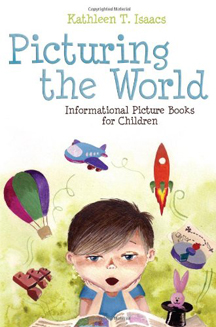Picturing the World
 Picturing the World: Informational Picture Books for Children, by Kathleen T. Isaacs. Published by ALA Editions, 2012. 216 pages.
Picturing the World: Informational Picture Books for Children, by Kathleen T. Isaacs. Published by ALA Editions, 2012. 216 pages.
At a time when informational books have suddenly been given the spotlight by Common Core, Kathleen Isaacs’ thoughtful and thorough guide to the best informational picture books of the last several years has become an even more invaluable resource.
Isaacs starts with the basics–what exactly is an informational book and what is a picture book? By clarifying this from the get-go, Isaacs helps us understand why she included what she did. She also underscores the relationship–and it is not a synonymous one–between informational picture books and books that are shelved in nonfiction in the library.
Perhaps most importantly, she examines the use of poetic license head on. No, the sun does not really talk to us, but in Molly Bang’s Living Sunlight, for example, the use of the sun as a narrator gives structure and meaning to the story. Isaacs also addresses the various awards (including the Sibert) and advises readers to look closely at the criteria to better understand how to use awards, honors, and notable lists as selection tools.
The book is organized by subject matter: Ourselves and Our World at Home and School; The Natural World Around Us; The World We Make; The Things We Do; The World of Faith and Festivals; Our World in History; and Our World Today. The helpful appendices include the mentioned awards and best-of-the year lists as well as subject, title, and author and illustrator indexes. The titles included range from 14 Cows for America to Zero Is the Leaves on a Tree, and from What’s Inside Your Tummy Mommy? to Book Fiesta and 246 more.
Veteran reviewer Kathleen Isaacs makes the most of each annotation of the 250 included books. With concise descriptions that nevertheless provide plenty of substance and key bibliographic detail, this is truly a must-have for any librarians wanting to boost their informational text collection. Each annotation also specifically speaks to the informational text component, noting when source information is or is not acknowledged, what types of backmatter are included, and helpful presentation tips such as pairing possibilities. At a time when teachers and librarians are digging deeper into the Common Core, it is more helpful than ever to have an authoritative resource that covers books that meet young people’s informational text needs and are readily available.
– Reviewed by Ellen Myrick
